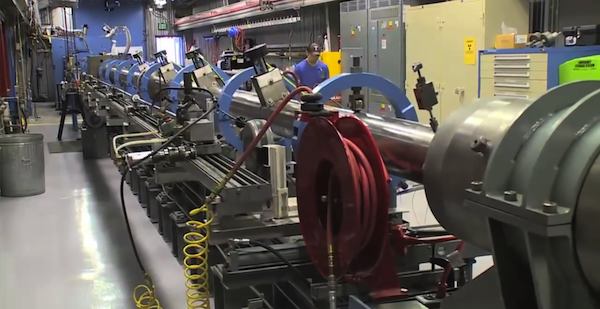
[Image above] Credit: LosAlamosNationalLab; YouTube
Los Alamos National Lab has some really big guns.
The gas and powder guns, housed in LANL’s Explosives Center, aren’t just for show—they help scientists better understand materials by providing really detailed information about what happens in those materials in response to compression.
What follows is an exclusive email Q&A with LANL’s Dan Hooks, director of the Explosives Center, about their guns—and be sure to continue all the way to the bottom to watch a video of the guns in action!
What types of questions are experiments with these guns used to answer? What kind of information can they provide about a material?
The guns are used to create a highly controlled dynamic state of uniaxial (one-dimensional) compression stress in a material. With timing and velocity diagnostics, including interferometry techniques, shock and “particle” or mass velocities are recorded. And through conservation of mass, momentum, and energy, these quantities are used to calculate the compression of the material in terms of pressure and density.
The dynamic state can then be compared to static compression techniques to reveal the differences between static loading (as in the center of the earth) and dynamic loading (as in a meteor impact). Imaging diagnostics, like X-rays and optical imaging, can be used to show events in the material at the micro-structural level, including collapse of voids and crushing of grains, etc.
Diffraction diagnostics can also be used to show material phase and lattice deformation pathways, and chemical diagnostics can be used to show decomposition pathways in reactive materials. All of these techniques remain developmental to access ever faster and ever finer details—ultra-fast processes are inherently difficult to study, and thus many questions remain!
Are the guns used to examine ceramic materials, and can you provide an example of how they’ve been used in the past?
Yes, ceramic materials are commonly studied—in fact, they’re one of the standard materials types used for experiments even when they’re not the primary subject of study. The compressed state of materials is very important in many applications, from planetary science to other uses of materials in extreme environments.
In Los Alamos, going back to the 1950s, many materials were studied in their compressed states with gas guns. These studies led to a published volume of dynamic compression responses (LASL Shock Hugoniot Data by Stanley P. Marsh, UC Press, 1980) and others for specialty materials like explosives (LASL Explosive Property Data by Terry R. Gibbs and Alphonse Popalato, UC Press, 1980). Many of these were ceramics, ranging from rocks and minerals to high-quality ceramic materials for scientific and commercial applications.
Several very well-characterized ceramics are used in experiments daily, such as for impactors (the front face of the gun projectile) to create a high pressure state, interferometry windows to provide a well-characterized interface state, and others from optical fibers to port windows to optical delays in interferometers.
As objects of study, aside from the previously mentioned planetary physics applications, ceramics can act as components of energy-absorbing materials and composites, and, as such, their dynamic response is of interest. Many scientific publications describe both the practical applications and standard development aspects of ceramics in dynamic high-pressure science.
How many guns are there, what is the approximate cost of one of the guns, and how much does it cost to fire one of the guns?
Such guns are commonly used in dynamic compression science, although dynamic compression science itself may not be so common. In Los Alamos, there are approximately 7–10 such guns for various purposes. The guns can be designed to create varied pressures for varied durations, and the size and maximum velocity of the impacting projectile is varied to create these states. The bore (projectile diameter) can vary from about 12–100 mm, and the velocities can be a few hundred meters/s to 8+ km/s.
The firing operation can involve relatively low pressure gas, as delivered from a standard lab cylinder, up to many thousand psi. The type of gas itself is varied depending upon desired velocity, since the ultimate velocity of the projectile is limited by the speed of sound of the gas used to drive the projectile. Thus, argon can be used to drive low velocity shots, helium for intermediate velocities (a few km/s), and hydrogen for high velocities.
Alternatively, propellant powders can be used to drive a projectile directly or compress another firing gas with a preliminary stage piston. As a standard technique, there are many scientific guns in use at the national laboratories, notably including the brand new “Dynamic Compression Sector” of the Advanced Photon Source at Argonne National Laboratory. Several universities, including Washington State University and Purdue University, also have guns.
Given the many variables of the guns themselves and the types of experiments that are performed with them, the costs of the guns and the experiments are very highly variable. For those interested, the new facility at Argonne is opening to users early in 2015.
Credit: LosAlamosNationalLab; YouTube
